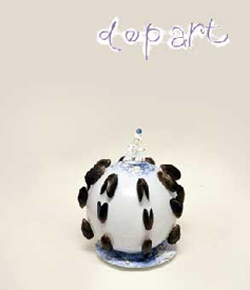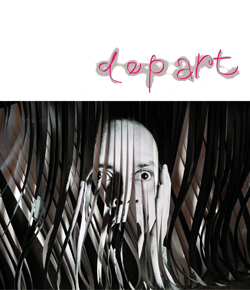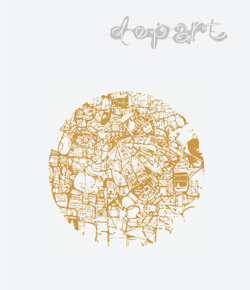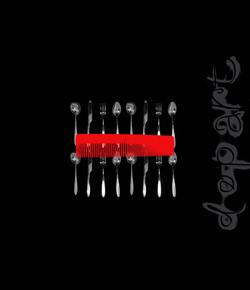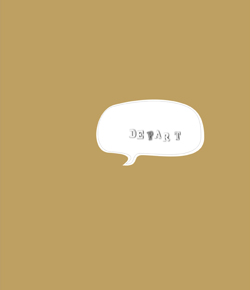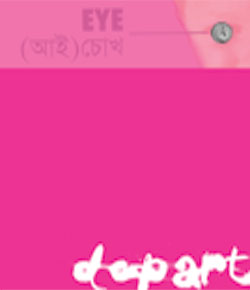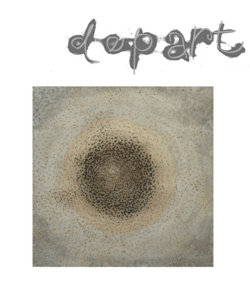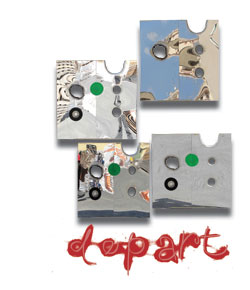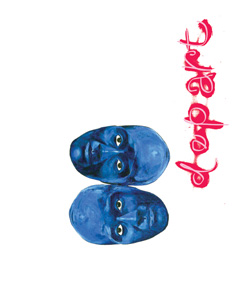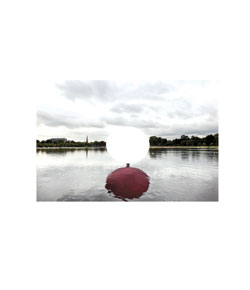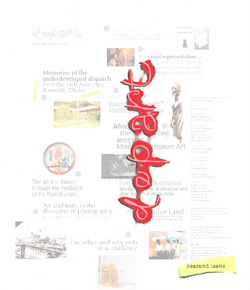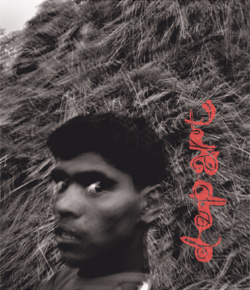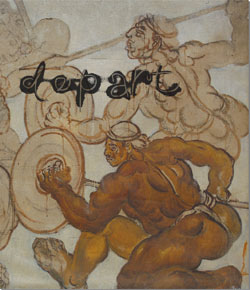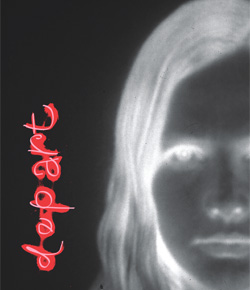Features
Six theses on Abstraction
An absolute aesthetic construction

Bangladesh's mainstream narratives on abstraction are often absolutist in stance. Anchored in the essentialist assumptions around art and life, some of them simply do not register the contextual reading of the arts. In effect, art is perceived as independent of the 'real world' having an unalterable character and countenance.
The idea of art having an autonomous and immutable springboard shuttles the entire spectrum of artistic productions, and the web of signification it yields, into the realm of 'divinization'. Thus art is considered to be generative of values that are perpetually attached to what is 'Highbrow'. The elitism that is the driving logic behind such 'highbrowfication' of art sits easy with hierarchy and power. Thus art is made to look like something eternally shrouded in mystery, to the point that it assumes a characteristic akin to a religion.
Interestingly, the ones who propel art into the direction of an obscure and mystified world are the very same people who seek to attain objective knowledge in all spheres of life. Art for them is part and parcel of the process of aestheticization of the society – as it is envisioned through an 'idealist' set of prism. The resultant paradox seems to make explicit a design which tends to interfere with every attempt at reproducing society and social processes and relations in materialistic terms.
With the context shorn off, art is perceived as a form of pure aesthetic exercise verging on the mystical. Granted that ambiguity is something that afflicts modern and even some pre-modern art forms, but to cultivate a fixed notion – a single point perspective – to view art and artists, is being in perpetual denial of the true nature of art and the value it generates in a given social environ, through processes which are in constant flux. The truth of the matter is: 'art' itself seems to pigeonhole the very fixities and norms some so passionately feel all acts of creation is bound up with.
Abstraction and punctuationism


Gross generalization has become the convention in artistic discourses in Dhaka's cultural arena, often giving rise to vacuous claims and counterclaims. If profusions of words and emotion colour all discussions on 'art proper' as well as the artists behind their production, they seem to yield little more than paean and penmanship.
Punctuationism disrupts discourses. The act of abruptly cutting short the possibility of continuity in discoursing has successfully defused the critical attitude to art and life. Moreover, discourses have become the prerogative of some who seem to want to utter the final say as the ultimate arbiter of truth. Seen through the mainstream obsession with objectivizing/normativizing tendencies, such discourses are rarely actual discourses and are never ever contextual.
We encounter an absurd claim on a paper titled 'In Search of the Origin of Abstraction', by Imtiar Shamim, where the writer says: 'As we navigate through abstract works to find its aesthetic premise, we often try to look for the social and political context. The misconception and bewilderment that abstraction gives rise to are linked to such unwarranted curiosities.' In the early 1980s, even the most revered art writer and litterateur, Syed Ali Ahsan, answering a question on art and the assumed Islamic injunction on the representation of humans and animals in art, delved into similar shortsightedness. Asked about the problem of representation of the living beings in Islamic tradition, he was abrupt in his answer while his words were symptomatic of the punctuationist tradition: 'Modern art is abstract,' was his final answer, which renders all forms of interrogation null and void.


Within the absolutist/essentialist purview one allows little space for debate denying the fact that even abstraction has many different faces and personalities and needs multiple voices, or speeches to do justice to all of them. Yet this is where the punctuation is drawn and all discussions on art ends without making sense or making any serious effort in reproducing what actually exists as art. Punctuationism also negates the fact that by employing certain discursive apparatus we are able to discover art's springboard – its social context and the originary sources.
Of classification and naming


The punctuationists often draw demarcation lines around discursive as well as artistic patterns. For them these are irreversible boundaries which ensure adherence to fixed patterns: once the categories have been cast, all art objects remain resident in the place assigned for them under the names given to them. When we start making value inquiry, we need to cluster certain form of art into a certain category or another, but what if that category simply fails to capture the true nature of the art in question and the multiplicity of characters it often assumes? This is how we come to the realization that, if applied to attain arbitrary ends, the very act of categorization tends to overlook the fact that all categories are contextual and is subject to revision once new knowledge appears affording new reading of the same old text or art form.
What ails this nation is also the absence of actual discursive practices through which arguments are formed to defend ones respective bastion. Galen Strawson defines an a priori argument as one in which 'you can see that it is true just lying on your couch. You don't have to get up off your couch and go outside and examine the way things are in the physical world. You don't have to do any science.' It is obvious that puctuationists are least inclined to accept such method of generating knowledge as they are in the habit of drawing conclusions arbitrarily, without resorting to judgment possible through a priori and a posteriori knowledge; if the former is transcendental in nature the later arises from experience.


All objects are part of a fluid construction – which is the Whole, and it is through knowledge that we try to understand and qualify them. Though things appear to us in fragments we, as humans, can only construct the whole out of the scraps and parts we encounter on a daily basis. In the absolutist tradition thinking is a regulatory frame and categories are fixed single point entry into areas that are independent of one another.
In this process of cognitive organization, if the complex relationship between language and knowledge is ignored, the process itself often serves to reinforce the simplified, reductive, and monolinear interpretation of the social topology as well as that of the arts. In art, it only contributes to creating generalized point of views based on dualities such as abstract-representational, modern-traditional, form-content, ignoring the fact that at times one easily slides onto the other.
To Marx, 'categories are not chaotic,' as they are needed to lend clarity to our process of (re)cognition. Loss of category may mean loss of clarity, but, the more inclined we are to lend primacy to one category over another, the more we are willingly to revert back to chaos. Also, all categories are part of the Whole, as such cannot be seen as independent of one another; they are more like nuances in a single spectrum.
As for abstraction, perceived as a category of the purest of all expressions in art, we may conclude that only the 'autocrats' enforce such arbitrary construction of hierarchy. We may borrow Ludwig Feuerbach's remark on Christianity – 'it is nothing more then a fixed idea.' In reality, ideas and categories are a way for us to get a glimpse of the 'whole' which is in constant flux and can only be made to appear partially by producing commentaries and reproducing the contexts.
Reading art contextually, textually and even as performativity

Art not only gives rise to appreciative gaze, but also provides knowledge – critical and otherwise – about the gaze. It often problematizes the normative gaze by interrogating the very idea of developing such fixed gaze to look upon the world. The European avant-garde, at the turn of the twentieth century, effectuated radical departures from the fixed frame of representational technique based on Renaissance naturalism. That 'gaze shift' came about only as the object of art has been re-aligned either in relation, or antagonistic to, the objects/goals of the society. Modernity was slowly divesting the social spaces of all traces of individuality, difference, and most of all spirituality, and some of the artists were devising their works as the last outpost of the sublime and the preternatural. This has been the driving force behind the entire machinery, of which art and society are part, to have worked as a conduit of the language of abstraction. That it has been a part of a long-drawn social process can be detected in the production of both art and knowledge along this line – from the very first experimentation with forms and shapes by Cezanne to the radical splintering of the pictorial space introduced by Picasso and Braque at alter date – which finally ensured flattening of the surface as an antidote to the much vaunted traits of perspective and the illusion of depth tied to the Renaissance.

The logic of the 'new' tendencies can never be fully fathomed without the context of the clashes of values between Renaissance humanism that reigned supreme in Europe for about five hundred years or so and the emerging society of the twentieth century where mechanization threatened to devour the individual. Also important is the surge of the scientific knowledge, reasoning – which equipped the human with an analytic prism. And add to that the most important component of the resultant dynamic following the rise of the Capital, to reconstruct the background from which the alienated modern individual operated, claiming his place in, and also exerting his power on, a society in transition; all this is constitutive of the context through which to discover the seedbed of abstraction.
The new material condition gave rise to new values propelling the art scene of the West into a perpetual state of movement. We witness the dynamic of the New Age manifested in the dialectic relation between Enlightenment's emphasis on reason and scientific knowledge and the individual's effort to break free of essentialist position on art and life, we see its reflection in a painting by J M Whistler. The work in question, titled 'Nocturne in Black and Gold: The Falling Rocket' (1872), straddle the line between empiricism and the new attentiveness to the quality of the surface, a tendency being the sole reason behind unleashing of the new trend – manifested in a quick dash towards flattening of the pictorial space. That the social dynamic effectuated a new dynamism in art, was evidenced in the quick-paced evolution from the Cubist conceit of fragmentation of the represented element and flatness to Kandinisky's call to natural instinct by not representing nature in its likeness.
Sense of displacement of the self
Wilhelm Woringer, the German philosopher and art historian whose work titled 'Abstraction and Empathy' lends abstraction its necessary theoretical foundation in the modern times, who, on a different tenor, in the same book, says: 'While the tendency of empathy has its condition of happy pantheistic relation of confidence between man and phenomena of the external world, the tendency of abstraction is the result of a greater inner conflict between man and his surroundings and corresponds in religion to a strongly transcendental colouring of all ideas .This state we might call a prodigious mental fear of space.'


Black and Gold: The Falling Rocket, 1872.
Therefore, what we may easily detect is the microcosmic dynamic that governs the relationship between the individual artist and his/her environ. When this dynamic is afflicted by the artist's fear of place or context, all articulations are redirected towards an unknown destination – leading to abstraction.
The fear epitomized by such art form brunches out in psychological traits other than fear itself, and the same fear (of place) also gives rise to the desire to overcome fear. For this very reason abstraction appears as a sublimation process as the unconscious psychological strategies brought into play by artists and general people alike to 'cope with reality and to maintain self-image'. In Freudian term, displacement operates in the mind unconsciously and involves 'emotions, ideas, or wishes being transferred from their original object to a more acceptable substitute'. As artist when one disengages himself/herself from ones context/place or remains in denial of it, thus, the vanishing of the present is ensured through the construction of its 'other'. Hence this process of creating a personalized field of play – or call it a neuter zone, where the smack of actual place, or the habitat and its constitutive elements are not to be found, is actually a therapeutic effort. Abstract art is a phenomenon that emerges from the pre-subjective disposition, or frame of mind which departs from spatio-temporal existence of the individual artists to enter a realm of reflection, imagination and thought.
The point of departure following neutralization of pictorial space

Since abstraction indicates a departure from reality, it gives rise to several exit points as there are differences in the subjective position. Therefore, if art is considered to be the creation of otherness through some subjective means, it only serves to explicate that the multiplicities of what is sensed, seen or perceived, eventually lead to a wide range of possibilities.
Once we accept, without consideration, that the existence of all these differences are located at a single point, the subjective spirit that usually inaugurates what is transgressive in art is abandoned. in Bangladesh this transgressive-transcendentalist approach to art has been totally lost to the tendency to homogenize. A gross misrepresentation occurs in the discursive domain, when the entire trajectory of art, where extremely antagonistic trends and tenors commingle, is considered to be of one single strand. Discussion on art, especially in Bangladesh, often takes a linear and descriptive form, and at its worst, an abstract monologue, merely to echo the commentaries of the artist. In absence of a critical apparatus, or hermeneutical models, equivalent to that of the West, all discourses are bound to be impersonal, asocial, ahistrocal, apolitical and immaterial.


The Western form of abstraction, which had provided the basis for the first generation abstractionists to eclipse the art of the previous era, has so far been accepted here without taking into consideration the dynamics of negotiation where confrontations and also intuitive responsiveness seemed to be the order. As through acculturation of the 'new', which of course is the borrowed 'new', Bangladeshi abstract art in the 1960s somehow managed to stage a new beginning, but failed utterly to achieve the momentum throughout the -70s and -80s.
If the transgression mentioned above is seen as the politics of rejection of the status quo, in Bangladesh, it served, especially in and through the 1960s abstraction, as an apparatus to evade the ongoing political turmoil and the counternarratives on the making. It was more like a celebration of the discovery that painting is possible without references to the real world and the medium-specific exploration that produces pictures where sumptuousness is the sole attraction.


The concept of 'celebrating' the separation of art and society, from the onset, plagued the art scene of Dhaka, often leading to the reification of artistic production. This kind of 'celebration' neither has anything to do with transcendence nor is generative of any new spatial-temporal axis that may institute a change.
This politics of the creation of the otherness, on the other hand, invites the audience to look for differences, multiplicity of possibilities, while setting aside what is often accepted as norm or convention. The erasure of the image demands the creation of the other, so that creation, not mimicry, is instituted.
All artistic expression is synecdochical, which reinforce the fact that representation has always been elastic. As a site which can be dubbed as 'nowhere' in the midst of 'here and now', the sanctuary created by art in general, often functions as a place from where re-evaluation, re-generation and reformation starts. The migration to such a neutral site is justified only if it engages the viewer without neutralizing the imaginative responsive mechanism, and in opposition to passivity, generates activity or 'doing' on the part of the onlooker. The most important question that waits in the cue is, whether Bangladeshi abstraction has been informed by such mental effect and the fact that there was a people waiting to take in the impact of such a phenomenon and re-organize their sensory horizon accordingly.
Translation – DEPART DESK




